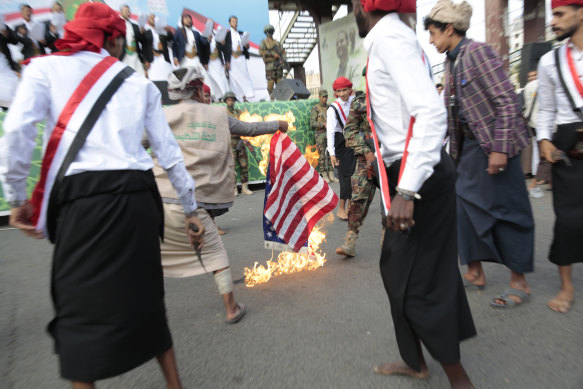Home » World News »
Who are the Houthis? Yemen-based militants join the Israel-Hamas conflict
Save articles for later
Add articles to your saved list and come back to them any time.
The Yemen-based Houthi movement has joined the Israel-Hamas war, extending the conflict to the far side of the Middle East.
In firing missiles on Israel, it has joined other Iran-backed militant groups including Hezbollah, which has been exchanging fire with Israeli forces across the Lebanon border.
While not the officially recognised government of Yemen, the Houthi movement controls a significant portion of the country and its involvement goes against the West’s efforts to prevent the fighting from spreading.
Where is Yemen? The Middle East nation lies at the southernmost point of the Arabian Peninsula and shares a border with Saudi Arabia to its north and Oman to its east. Its coastline is on the southern end of the Red Sea (the Suez Canal is at the northern end) and represents a strategic choke point for world shipping and, crucially, Saudi oil.
Has Yemen declared war on Israel? The Houthi movement, which controls Yemen’s west, says it launched ballistic and cruise missiles on southern Israel on Wednesday (AEDT). The Israel Defence Forces said it intercepted at least one missile originating from near the Red Sea, along with other “aerial threats”. Houthi military spokesperson Yahya Saree said it was behind two earlier incidents, a drone attack on October 18 and three cruise missiles intercepted by the US Navy on October 19.
Yemen’s Houthi movement, not Yemen itself, has effectively declared war against Israel. Yemen’s internationally recognised government, which is backed by the Saudi and US governments, has been in a civil war with the Houthis since 2014, though much of the violence has settled during the past year amid back-channel peace talks between the Houthis and the Saudis.
Why is Yemen involved in the conflict? Like other militant groups getting involved in the Israel-Hamas conflict, the Houthis are backed by Iran and are part of its “Axis of Resistance”.
Saree said Israel was to blame for the region’s conflict and that the Houthis would continue their involvement “until the Israeli aggression stops”.
Mohanad Hage Ali of the Carnegie Middle East Centre said the few Houthi attacks were, for now, “more about messaging than a real military threat”.
Saudi Defence Minister Prince Khalid bin Salman (right) meets a delegation from the Houthi movement in Riyadh, Saudi Arabia, in September this year.Credit: AP
“The risk to Israel would be if there is an all-out engagement, with multiple rocket launches from all directions which could overwhelm the air defences,” he said.
Who are the Houthis? The Houthi movement, also known as Ansar Allah (Supporters of God), developed in the 1990s out of dissatisfaction with Yemeni government alignment with Saudi Arabia and the US. It has positioned itself as an anti-imperialist group against foreign intervention and as a force for economic development for Yemeni people.
The group’s slogan reads “God is Great, Death to America, Death to Israel, Curse on the Jews, Victory to Islam”, something it has claimed is not literal but symbolises its opposition to interference by those countries.
It was subject to arrests in the early 2000s amid concerns over its growing influence and responded with insurgencies that embarrassed the Yemeni and Saudi militaries.
Houthi supporters in Yemen’s capital, Sanaa, burn an American flag in September 2021 during a rally to mark the seventh anniversary of the Houthis’ takeover of the capital.Credit: AP
The group is rooted in Zaydism, a sect of Shiite Islam that accounts for about 25 per cent of Yemen’s population; the rest of the country is predominately Sunni. Middle Eastern politics can practically be split along the two main branches of Islam – Shiite and Sunni – centred around major players Iran (Shiite) and Saudi Arabia (Sunni).
Are Houthis aligned with Hamas? The group is aligned with Iran’s Axis of Resistance, an informal military coalition centred on anti-Western and anti-Israel intent. Other participants include Lebanon-based militant group Hezbollah; Hamas and other Palestinian militant groups; the Syrian government; Taliban-led Afghanistan; and militant groups in Iraq. Most of these groups share Iran’s faith in Shiite Islam.
Hamas, a Sunni-based group, is unusual in that it has crossed the Shiite-Sunni divide. This is not so surprising considering Saudi Arabia has long been close with the West and was even working on normalising ties with Israel. The Houthis first indicated a link with Hamas in 2021 when they suggested swapping Saudi prisoners they held for the release of Palestinians. Hamas later presented the Houthi leadership with a “shield of honour” in recognition of support for the Palestinians.
With Reuters
More coverage of the Hamas-Israel conflict
- Cascading violence: Tremors from the Hamas attacks and Israel’s response have reached far beyond the border. But what would all-out war in the Middle East look like?
- The human cost: Hamas’ massacre in Israel has traumatised – and hardened – survivors. And in Gaza, neighbourhoods have become ghost cities.
- “Hamas metro”: Inside the labyrinthine network of underground tunnels, which the Palestinian militant group has commanded beneath war-ravaged Gaza for 16 years. The covert corridors have long provided essential channels for the movement of weapons and armed combatants.
- What is Hezbollah?: As fears of the conflict expanding beyond Israel and Hamas steadily rise, all eyes are on the militant group and political party that controls southern Lebanon and has been designated internationally as a terrorist group. How did it form and what does Iran have to do with it?
Get a note directly from our foreign correspondents on what’s making headlines around the world. Sign up for our weekly What in the World newsletter.
Most Viewed in World
From our partners
Source: Read Full Article




